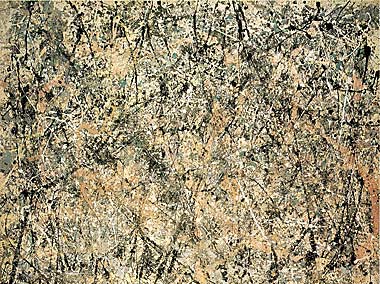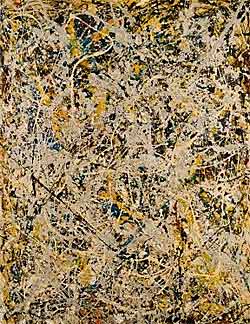| |
|
|
| |
Abstract Expressionism - a Movement
Author: Russell Shortt
Abstract Expressionism was a movement that originated in post World War II America, it was the first American art movement that became globally influential and it replaced Paris with New York as the centre of the art world. Abstract Expressionism does not describe one particular style but rather an attitude rooted in a need to express individuality and improvise spontaneously. The movement's name is derived from the influences of the emotional intensities and self denial of the German Expressionists and the anti-figurative aesthetic of the European abstract schools such as Futurism, Bauhaus and Synthetic Cubism. Many modernist artists had fled Paris during World War II, many of whom settled in New York. The modernist movement in New York was influenced by Picasso, Matisse, Miro, Surrealism and Cubism. Jackson Pollack, one of the leading lights in the movement in New York was to re-define the way that art was created. Pollack placed large canvases on the floor, so it could be approached from all sides - smashing prior restrictions on the artistic process - he took the easel and stuck it up art's ass. Abstract Expressionism was on it's way, Pollack had made it alright and damn well encouraged everybody to think out of the box and explore new ways to approach and make art. It must be stressed that the movement was not constituted of artists of the same style, far from it, in fact some of the artists in the movement did not produce works that were either abstract or expressionist. Indeed, some art critics labelled the movement Action Painting or New York School. Broadly speaking, there were two distinct groups in the movement - those who worked with simple, unified blocks of colour, like Rothko, Newman and Still and those who made use of Surrealist techniques of automatic art, like Pollack, De Kooning and Hofmann. All were influenced by Existentialist thinking, which emphasised the importance of the act of creating and not the finished object.
Article Source:
http://www.articlesbase.com/art-articles/abstract-expressionism
-a-movement-759349.html
About the Author:
Russell Shortt is a travel consultant with Exploring Ireland, the leading specialists in customised, private escorted tours, escorted coach tours and independent self drive tours of Ireland. Article source Russell Shortt,
http://www.exploringireland.net http://www.visitscotlandtours.com |
|
| |
|
|
| |
|
|
| |
|
|
| |
Abstract Expressionism
Centered in New York City, 1946 to 1960's (see also Action Painting, Color Field Painting)
Abstract Expressionism is a type of art in which the artist expresses himself purely through the use of form and color. It non-representational, or non-objective, art, which means that there are no actual objects represented.
Now considered to be the first American artistic movement of international importance, the term was originally used to describe the work of Willem de Kooning, Jackson Pollock and Arshile Gorky.
The movement can be more or less divided into two groups: Action Painting, typified by artists such as Pollock, de Kooning, Franz Kline, and Philip Guston, stressed the physical action involved in painting; Color Field Painting, practiced by Mark Rothko and Kenneth Noland, among others, was primarily concerned with exploring the effects of pure color on a canvas. |
|
| |
|
|
| |
Abstract Expressionism
In the late 1930s and early 1940s, around the outbreak of World War II, many Surrealists fled Europe and settled in New York. Their interest in unmediated expression to reach the absolute soon influenced a young generation of painters struggling to find a voice for American art. The new movement, which became known as Abstract Expressionism, was heavily indebted to the ideas of the European pioneers of abstraction, including Vasily Kandinsky, whose work was championed in influenced a young generation of painters struggling to find a voice for American art. The new movement, which became known as Abstract Expressionism, was heavily indebted to the ideas of the European pioneers of abstraction....
Metropolitan: Abstract Expressionism
A new vanguard emerged in the early 1940s, primarily in New York, where a small group of loosely affiliated artists created a stylistically diverse body of work that introduced radical new directions in art—and shifted the art world's focus. Never a formal association, the artists known as "Abstract Expressionists" or "The New York School" did, however, share some common assumptions. Among others, artists such as Jackson Pollock (1912–1956), Willem de Kooning (1904–1997), Franz Kline (1910–1962), Lee Krasner (1908–1984), Robert Motherwell (1915–1991), William Baziotes (1912–1963), Mark Rothko (1903–1970), Barnett Newman (1905–1970), Adolph Gottlieb (1903–1974), Richard Pousette-Dart (1916–1992), and Clyfford Still (1904–1980) advanced audacious formal inventions in a search for significant content... Guggenheim: Abstract Expressionism
In the late 1940s and early 1950s Jackson Pollock, considered the foremost Abstract Expressionist, placed his canvases on the floor to pour, drip, and splatter paint onto them and to work on them from all sides, which set him apart from the tradition of vertical easel painting... de Kooning & Abstract Expressionism
...Of the other principal members of de Kooning's Abstract Expressionist cohort, only Philip Guston saw the 1980s, having spent his ultimate energies during the previous decade in one of the most remarkable artistic turnarounds of the last quarter century. For most of the 1970s, while engaged in this dramatic shift from an art of ethereal abstraction to one of darkly comic figuration, Guston was treated as an apostate by his contemporaries... Painting Action and Colorfields
Jackson Pollock's art conveys the mindset of Abstract Expressionism. Pollock argued, “The painting has a life of its own. I try to let it come through”. Pollock reveals the life of the painting through “actions,” an energetic technique of dripping and pouring paint on a canvas that is placed directly on the floor. Pollock explained, “On the floor I am more at ease, I feel nearer, more a part of the painting… Since this way I can walk around in it… Work from the four sides and be literally ‘in' the painting...” |
|
| |
|
|
| |
|
|
| |
|
This store brought to you by |
 |
|
|
|
|
|
|
| |
|
|
| |
Significant artists of the movement
|
|
| |
|
|
| |
|
|
|








